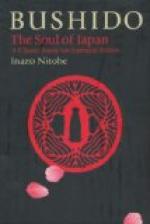If the premise is true that gracefulness means economy of force, then it follows as a logical sequence that a constant practice of graceful deportment must bring with it a reserve and storage of force. Fine manners, therefore, mean power in repose. When the barbarian Gauls, during the sack of Rome, burst into the assembled Senate and dared pull the beards of the venerable Fathers, we think the old gentlemen were to blame, inasmuch as they lacked dignity and strength of manners. Is lofty spiritual attainment really possible through etiquette? Why not?—All roads lead to Rome!
As an example of how the simplest thing can be made into an art and then become spiritual culture, I may take Cha-no-yu, the tea ceremony. Tea-sipping as a fine art! Why should it not be? In the children drawing pictures on the sand, or in the savage carving on a rock, was the promise of a Raphael or a Michael Angelo. How much more is the drinking of a beverage, which began with the transcendental contemplation of a Hindoo anchorite, entitled to develop into a handmaid of Religion and Morality? That calmness of mind, that serenity of temper, that composure and quietness of demeanor, which are the first essentials of Cha-no-yu are without doubt the first conditions of right thinking and right feeling. The scrupulous cleanliness of the little room, shut off from sight and sound of the madding crowd, is in itself conducive to direct one’s thoughts from the world. The bare interior does not engross one’s attention like the innumerable pictures and bric-a-brac of a Western parlor; the presence of kakemono[13] calls our attention more to grace of design than to beauty of color. The utmost refinement of taste is the object aimed at; whereas anything like display is banished with religious horror. The very fact that it was invented by a contemplative recluse, in a time when wars and the rumors of wars were incessant, is well calculated to show that this institution was more than a pastime. Before entering the quiet precincts of the tea-room, the company assembling to partake of the ceremony laid aside, together with their swords, the ferocity of the battle-field or the cares of government, there to find peace and friendship.
[Footnote 13: Hanging scrolls, which may be either paintings or ideograms, used for decorative purposes.]
Cha-no-yu is more than a ceremony—it is a fine art; it is poetry, with articulate gestures for rhythm: it is a modus operandi of soul discipline. Its greatest value lies in this last phase. Not infrequently the other phases preponderated in the mind of its votaries, but that does not prove that its essence was not of a spiritual nature.




